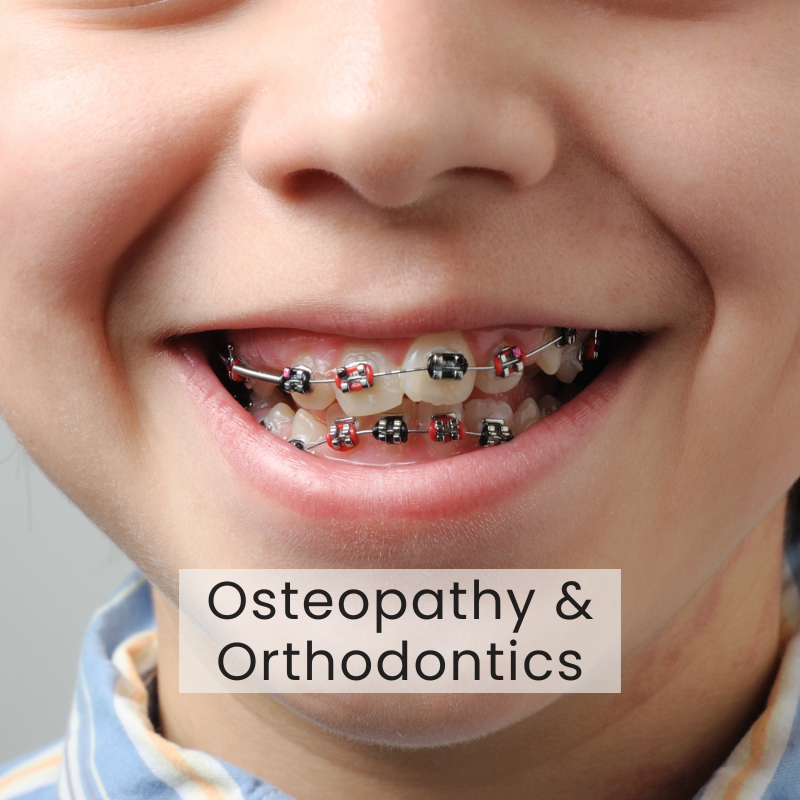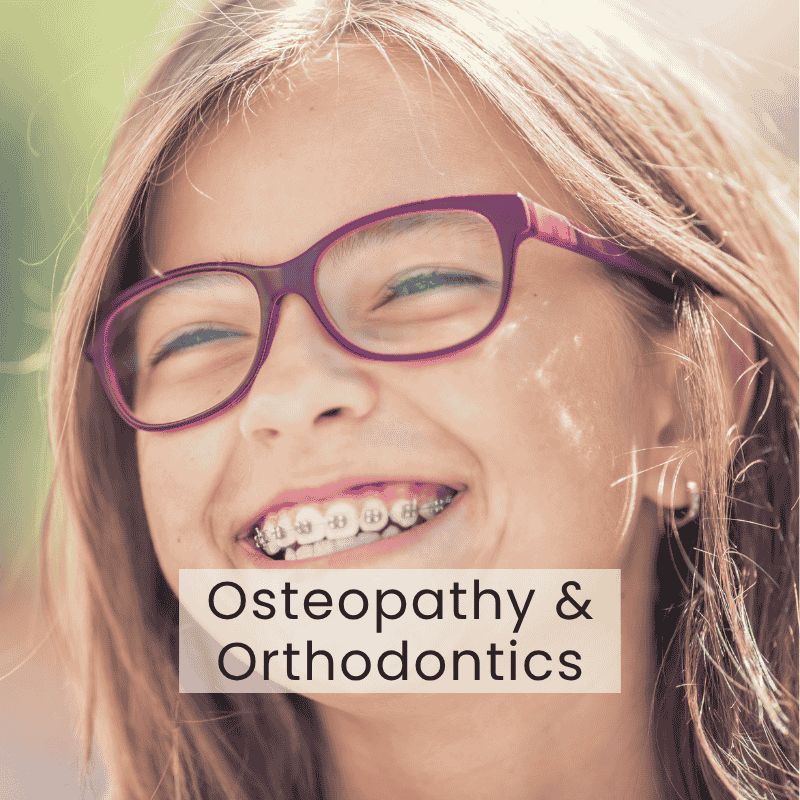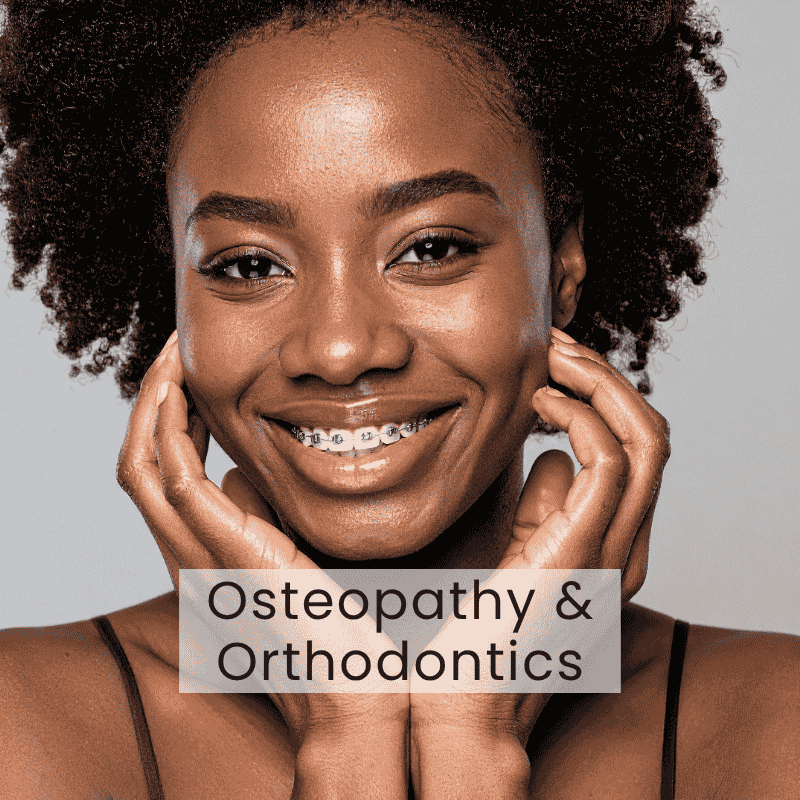Osteopathy and Orthodontics
Osteopathy and Orthodontics: A Patient’s Guide
Orthodontic treatment, whether through traditional braces or modern clear aligners like Invisalign, can transform smiles, boost confidence, and improve long-term oral health. Yet, while we often think of orthodontics as a straightforward dental process. There is much more going on beneath the surface of moving teeth into better alignment; teeth are not isolated structures: they sit within the jaw, which is influenced by muscles, ligaments, posture, and even breathing patterns.
This is where cranial osteopathy can play a valuable role. At our clinic, we frequently see clients undergoing orthodontic treatment who benefit from osteopathic support to alleviate discomfort, facilitate smoother progress and address the broader impact of braces or aligners on the body.
Orthodontics: More Than Straightening Teeth
Orthodontic treatment works by applying gentle but constant pressure to teeth, gradually shifting them into healthier positions. With Invisalign, this pressure comes from a sequence of clear aligner trays; with braces, it comes from brackets and wires.
While this process is safe and effective, the forces involved don’t just stop at the teeth. They ripple outward, influencing the jawbone, temporomandibular joints (TMJ), facial muscles, cranial bones, and even posture through the body’s interconnected system of fascia and musculature (Proffit et al., 2018).
Some people glide through treatment with little more than mild tenderness. Others experience symptoms such as:
Jaw pain or clicking (Osteopathy for TMJ)
Osteopathy for Headaches or facial pain
Difficulty adapting to changes in bite, perhaps mood swings
A sense of imbalance or tension in the body
These reactions are not surprising when the alignment of the mouth changes; the body must adapt. Osteopathy offers a gentle and effective way to help that adaptation process (Cuccia & Caradonna, 2009).
Osteopathy and Jaw Health
Osteopathy is a whole-body approach to health that recognises the deep interconnections between structure and function. When applied alongside orthodontic care, osteopathy can:
1. Support your Jaw
The TMJ connects the mandible to the skull, acting as a hinge for chewing, speaking and swallowing. During orthodontic treatment, the bite often changes, placing new demands on the TMJ. This can create tension, pain, or clicking sounds. Osteopathic techniques can release muscular tightness around the jaw, restore balance in the joint, and reduce strain on the surrounding structures (Al-Riyami et al., 2009).
2. Ease Muscle Tension
Facial muscles, particularly those involved in chewing (masseter, temporalis, lateral and medial pterygoids), often become overworked during orthodontic adjustments. Osteopathy helps relax these muscles, improving comfort and reducing headaches or tension that might arise (Magoun, 2011).
3. Encourage Symmetry
As teeth shift, the bite rebalances. Osteopathy can support this process by addressing restrictions between the cranial bones and facial structures, encouraging a smoother and more harmonious alignment (Pettman, 2007).
Posture, Bite, and Whole-Body Balance
What many people don’t realise is that orthodontics doesn’t just influence the mouth—it can affect posture throughout the body.
The jaw and neck connection: The TMJ and the cervical spine are closely linked via muscles and nerves. If jaw pain develops, the neck often compensates, leading to stiffness or pain (Cuccia et al., 2011).
The posture feedback loop: Poor posture (such as slouching or forward head position) can contribute to orthodontic issues like malocclusion (misaligned bite). Conversely, changes in bite during orthodontic treatment can subtly alter posture (Silvestrini-Biavati et al., 2013).
Breathing and swallowing: Braces or aligners may temporarily affect how the tongue rests, the process of swallowing, or even breathing. Osteopathy helps maintain freedom and balance in the chest, neck and diaphragm, supporting healthy breathing patterns (Chaitow, 2012).
By considering these whole-body connections, cranial manipulation ensures orthodontic treatment integrates smoothly into the wider musculoskeletal system.
What Osteopathic Treatment During Orthodontics Looks Like
When someone undergoing orthodontic treatment comes to our clinic, we tailor sessions to their individual needs. Here’s what you can expect:
Comprehensive assessment
We don’t just examine your teeth and jaw; we also consider your posture, breathing, and body mechanics. This helps us understand how orthodontic treatment affects your entire system.Gentle techniques
Osteopathy for orthodontics is not about forceful adjustments. Instead, we use cranial osteopathy to reduce strain and encourage balance.Focus on comfort
We often work directly with the jaw, head, and neck, but treatment can also include the shoulders, diaphragm and even the pelvis if postural patterns are contributing to imbalance.Ongoing support
Because orthodontic treatment unfolds over months or years, we typically recommend periodic osteopathic sessions to support each phase of change. Many patients find this makes the process more comfortable and reduces secondary symptoms.
Benefits of Combining Osteopathy with Orthodontics
The advantages of this combined approach include:
Reduced discomfort from jaw pain, headaches, or neck pain
Better adaptation to new bite patterns and aligner changes
Improved posture and reduced compensatory strain throughout the body
Support for healthy breathing and swallowing patterns
Enhanced sense of well-being during a process that can sometimes feel uncomfortable or stressful
Ultimately, osteopathy doesn’t replace orthodontics; it complements it. Just as an orthodontist ensures your teeth align correctly, an osteopath ensures your body integrates those changes smoothly.
A Holistic Perspective
At our clinic, we believe health is never isolated to one system. Teeth, bones, muscles, digestion, hormones, and lifestyle are all interconnected. That’s why our approach can combine osteopathy, Pilates, and nutrition, offering clients not just treatment but also long-term strategies for resilience and balance.
For those undergoing orthodontic treatment, osteopathy becomes an integral part of the bigger picture. It helps ensure that the positive changes happening in your mouth ripple outward into positive changes for your whole body.
Is Osteopathy Right for You During Invisalign or Braces?
If you are:
Experiencing jaw pain, headaches, or discomfort during orthodontic treatment
Noticing changes in your posture or neck tension
Looking for a more holistic way to support your orthodontic journey
…then osteopathy could be a great addition to your care.
We regularly collaborate with clients in orthodontic treatment to ease their symptoms and support their overall well-being. Whether you’re just starting wearing orthodontics, midway through, or finishing your course of braces, it’s never too late to add osteopathy into your routine.
Final Thoughts
Orthodontic treatment is a powerful investment in your health and confidence. Aligning teeth and improving bite creates benefits that last a lifetime. But the journey isn’t always smooth; your body must adapt to continuous changes in your jaw and bite.
Osteopathy offers a gentle, supportive, and holistic way to make that journey easier. By reducing discomfort, balancing posture, and integrating changes throughout the body, it ensures that the result of your orthodontic treatment isn’t just a beautiful smile, but also a comfortable, well-functioning body.
If you’d like to explore how osteopathy can support you during braces or Invisalign, we’d love to help.
Common Questions
What muscles does teeth grinding affect? Grinding commonly overloads the masseter and temporalis muscles, which may already be sensitive during orthodontic adjustments. By treating these areas, osteopathy helps reduce pain and improve comfort as teeth are gently moved into position.
What are the three types of orthodontic treatment? The primary approaches include fixed braces, removable appliances such as Invisalign, and functional appliances designed to influence jaw growth. Osteopathy can support all three by reducing compensations in posture and jaw mechanics.
How painful is orthodontic treatment? Orthodontic treatment can cause temporary soreness when appliances are adjusted or new aligners are fitted. Osteopathy can ease this discomfort by releasing tension in the jaw and neck, supporting better adaptation.
What are the red flags during an osteopathic treatment? When working with orthodontic patients, red flags would include sudden swelling, nerve changes, or severe, unrelenting pain that requires dental or medical review. Otherwise, osteopathy is a safe complementary approach alongside braces or Invisalign.
How long do osteopathic side effects last? Mild soreness after treatment may last 24–48 hours as the body adjusts, which is typically less disruptive than the ongoing discomfort associated with braces or aligners. Most patients report feeling looser and more comfortable soon after.
Are osteopaths allowed to diagnose? Yes, osteopaths can diagnose musculoskeletal and functional imbalances that may be contributing to orthodontic strain. They cannot diagnose dental conditions, but they work alongside orthodontists to support the body’s adaptation.
References
Al-Riyami, S., Cunningham, S. and Moles, D. (2009) ‘Orthodontics and temporomandibular disorders: a systematic review. Part 2: Functional disturbances, The Angle Orthodontist, 79(6), pp. 1063–1070.
Chaitow, L. (2012). Breathing Pattern Disorders and Functional Movement. Edinburgh: Churchill Livingstone.
Cuccia, A. and Caradonna, C. (2009) ‘The relationship between the stomatognathic system and body posture’, Clinics, 64(1), pp. 61–66.
Cuccia, A., Caradonna, C. and Caradonna, D. (2011) ‘The relationship between occlusion and posture: A systematic review’, Dental Research Journal, 8(4), pp. 142–148.
Magoun, H. (2011). Osteopathy in the Cranial Field. 4th edn. Indianapolis: The Cranial Academy.
Pettman, E. (2007) ‘A history of manipulative therapy’, Journal of Manual & Manipulative Therapy, 15(3), pp. 165–174.
Proffit, W.R., Fields, H.W., Larson, B. and Sarver, D.M. (2018). Contemporary Orthodontics. 6th edn. St. Louis: Elsevier.
Silvestrini-Biavati, A., Migliorati, M., Demarziani, E., Tecco, S., Silvestrini-Biavati, F. and Polimeni, A. (2013) ‘Clinical association between teeth malocclusions, wrong posture and ocular convergence disorders: An epidemiological investigation on primary school children’, BMC Paediatrics, 13(12), pp. 1–9.
Clinic Director and Cranial Osteopath with a special interest in supporting patients undergoing orthodontic treatment, inspired by his own personal experience.




